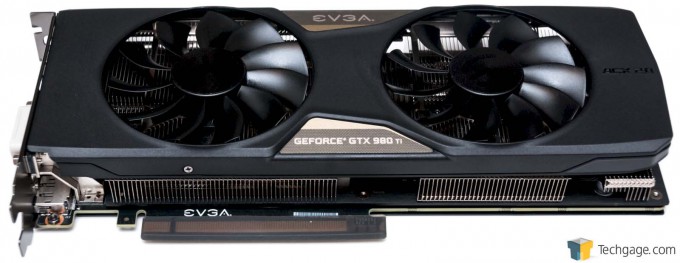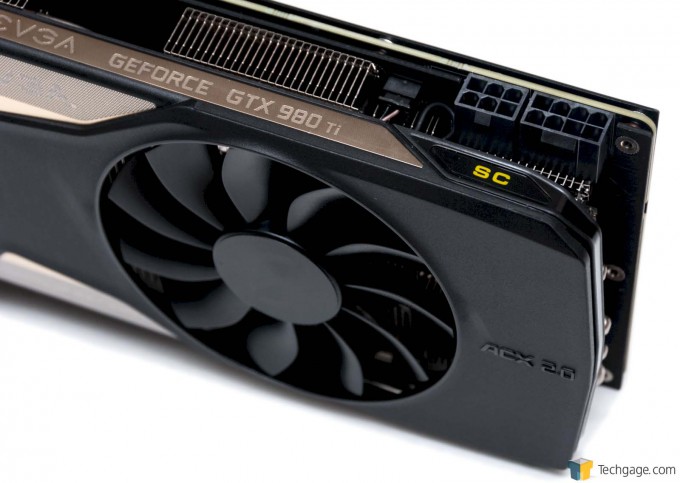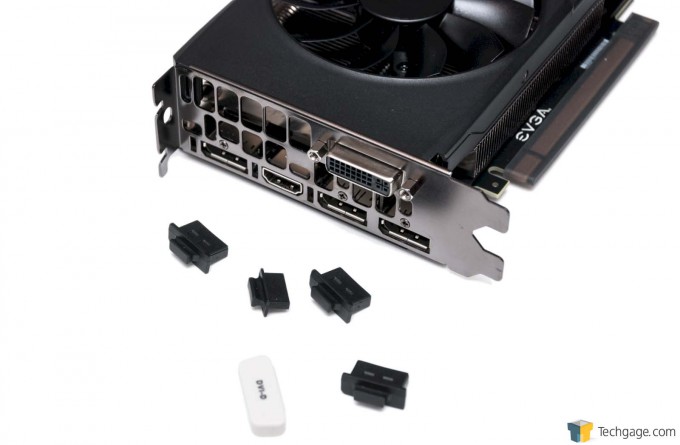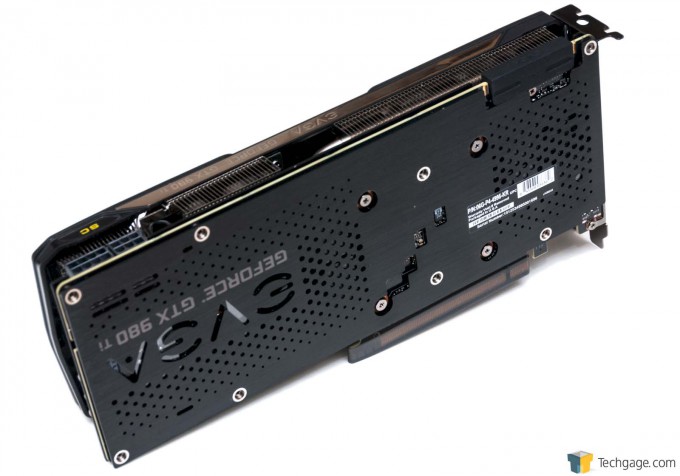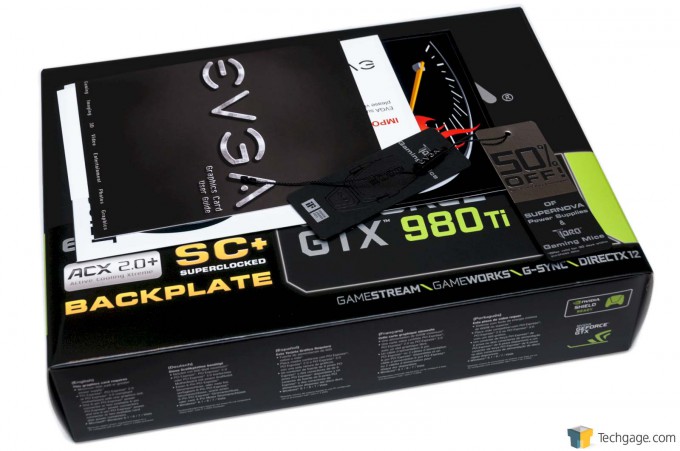- Qualcomm Launches Snapdragon 4 Gen 2 Mobile Platform
- AMD Launches Ryzen PRO 7000 Series Mobile & Desktop Platform
- Intel Launches Sleek Single-Slot Arc Pro A60 Workstation Graphics Card
- NVIDIA Announces Latest Ada Lovelace Additions: GeForce RTX 4060 Ti & RTX 4060
- Maxon Redshift With AMD Radeon GPU Rendering Support Now Available
EVGA GeForce GTX 980 Ti Superclocked+ Graphics Card Review

After taking a look at NVIDIA’s GeForce GTX 980 Ti in May, we summed it up as being the “new King Of High-end”. That being the case, it’s not hard to imagine that an overclocked take on the card, featuring a better cooler, would be anything but a winner. To test that theory out, we’re taking a look at EVGA’s Superclocked+ edition.
Page 1 – Introduction
In my look at NVIDIA’s GeForce GTX 980 Ti last month, I designated it the “new King” of high-end GPUs. That conclusion was reached based on the fact that it’s much faster than the GTX 980, warranting its $150 price premium, and costs $350 less than TITAN X, despite offering similar performance.
On the topic of “similar performance”, there’s one little thing that can help turn that into “better performance”, and EVGA’s Superclocked+ edition has it: a boost of 102MHz to the reference 980 Ti’s base clock.
Yup – this card is going to be fast.
In addition to the 102MHz bump, the GPU Boost clock displays an even beefier gain of 114MHz (settling at 1,190MHz). The only models that are faster in EVGA’s 980 Ti lineup are the liquid-cooled Hydro and HYBRID editions, both spec’d at 1,140MHz base and 1,228MHz Boost. Hydro costs $120 more ($799.99) than the Superclocked+ ($679.99), while the HYBRID (features an AIO cooler) costs $70 more. The Superclocked+ costs $30 more than reference ($649.99).
I should note that the Superclocked+ model itself has a $10 premium over the regular Superclocked. The differences between the two models is that the + has a backplate, used to bolster the durability of the card as well as reduce temperatures by up to 3°C. Purchasing the backplate as an add-on costs $20, so there’s some added value in purchasing the Superclocked+ up-front.
| NVIDIA GeForce Series | Cores | Core MHz | Memory | Mem MHz | Mem Bus | TDP |
| GeForce GTX TITAN X | 3072 | 1000 | 12288MB | 7000 | 384-bit | 250W |
| GeForce GTX 980 Ti | 2816 | 1000 | 6144MB | 7000 | 384-bit | 250W |
| GeForce GTX 980 | 2048 | 1126 | 4096MB | 7000 | 256-bit | 165W |
| GeForce GTX 970 | 1664 | 1050 | 4096MB | 7000 | 256-bit | 145W |
| GeForce GTX 960 | 1024 | 1126 | 2048MB | 7010 | 128-bit | 120W |
Outside of its performance, the best feature of the 980 Ti is its 6GB framebuffer. While I don’t believe 4GB is a harsh limit for most gamers, it can be for those looking to future-proof 4K gaming. That’s emphasized if we’re talking about multi-GPU configurations, since the performance made available would allow you to crank even a properly modern game’s detail levels. 6GB might seem like a hefty amount of VRAM right now, but down the road, it could become important.
I’m a big fan of the recent coolers NVIDIA’s been decking out its latest high-end GPUs with, and I admit (sorry, EVGA) that I’d prefer it over any third-party cooler. It just looks awesome. That said, EVGA’s latest ACX 2.0 cooler is no slouch, and does have some visual bits that I find quite nice. These include the etched name on the card’s top, and heatsink fins that can be seen from any angle.
As with the reference 980 Ti, EVGA’s Superclocked+ edition requires both an 8- and 6-pin power connector. Despite the fact that this card boasts a higher clock speed than reference, EVGA still considers this to be a 250W TDP part. Interestingly, it might have the right to, as we’ll see on the final page of this review (hint: it doesn’t draw that much more than the reference card).
Also similar to the reference 980 Ti, this card has 3 DisplayPort connectors, 1 HDMI, and 1 DVI. All of these are protected with rubber inserts, as are the SLI bridge and PCIe connectors.
At the back, we get a good view of the included backplate. A backplate can be a boring addition to a graphics card, but EVGA spices it up here by etching its name into the back, along with including the model of the card below it. When the card is installed, this branding will be properly facing you. As mentioned earlier, the point of a backplate is to increase durability as well as reduce temperatures. Versus a bare PCB, I also think it looks good.
Inside the box is a couple of coupons for some of EVGA’s other products (yes, you’re reading the “50% off” correctly), a wall poster, a couple of large stickers, as well as miscellaneous documentation.
On account of the fact that A) We know what the 980 Ti brings to the table, B) We know what recent Superclocked ACX 2.0 cards bring to the table, and C) We can gauge what a 102MHz clock boost can do, I have doubts we’ll be that surprised with some of the results. But, as a card that’s bound to be faster than a reference TITAN X, yet costs a lot less, I think the Final Thoughts section will be easy to write. But, before I get too far ahead of myself, let’s get right into some performance results.
Support our efforts! With ad revenue at an all-time low for written websites, we're relying more than ever on reader support to help us continue putting so much effort into this type of content. You can support us by becoming a Patron, or by using our Amazon shopping affiliate links listed through our articles. Thanks for your support!




